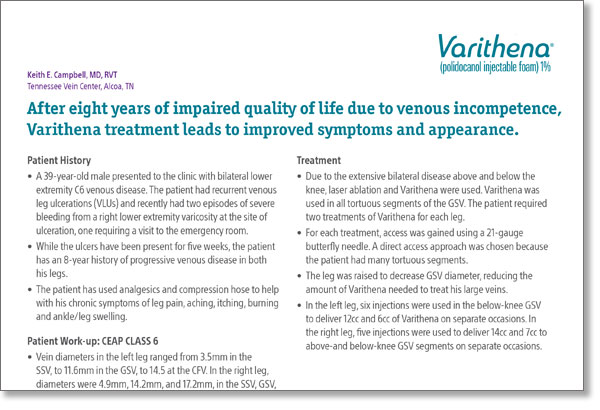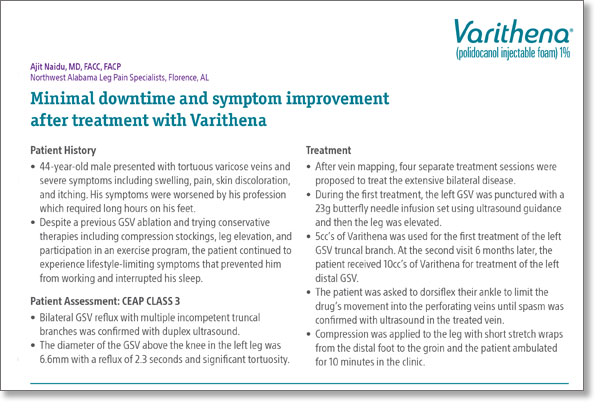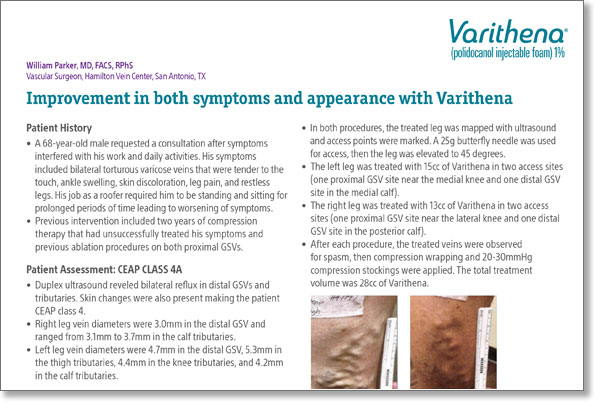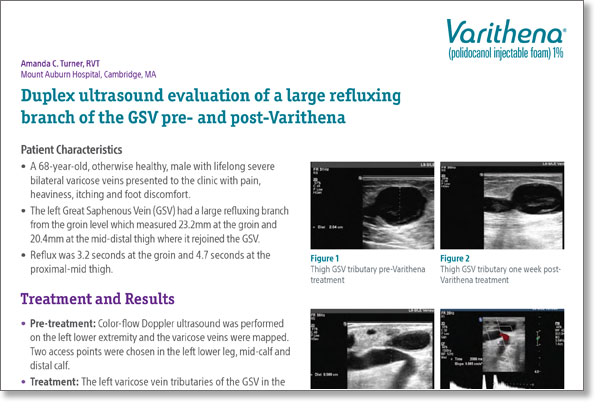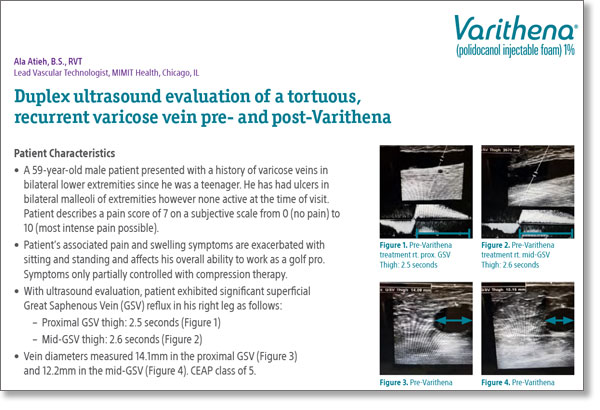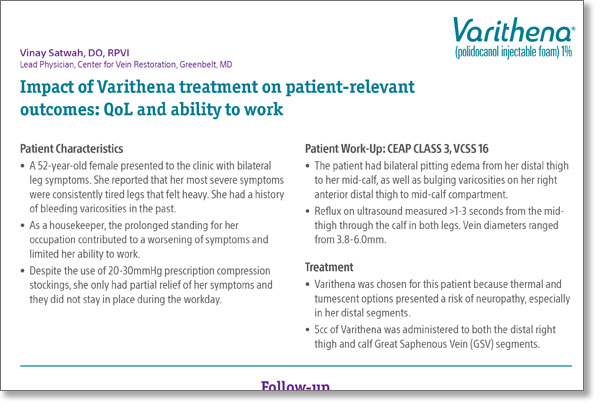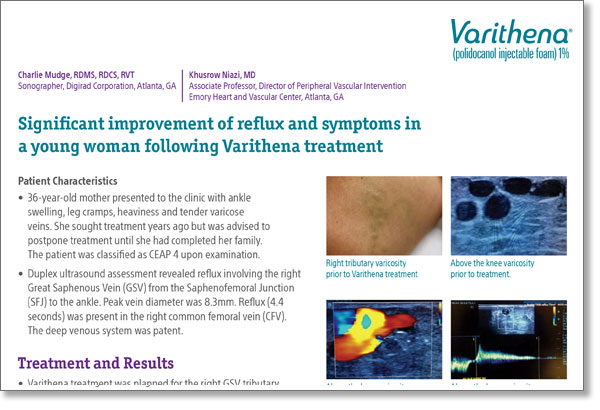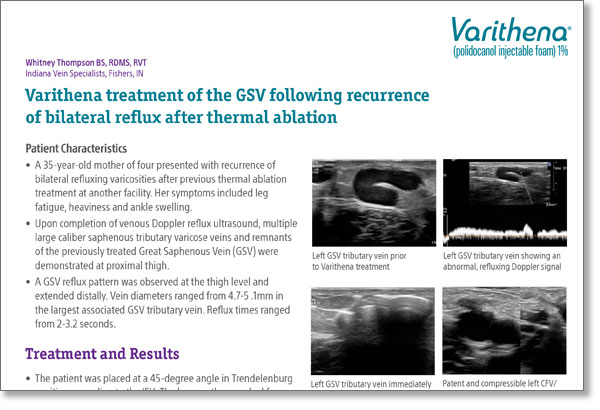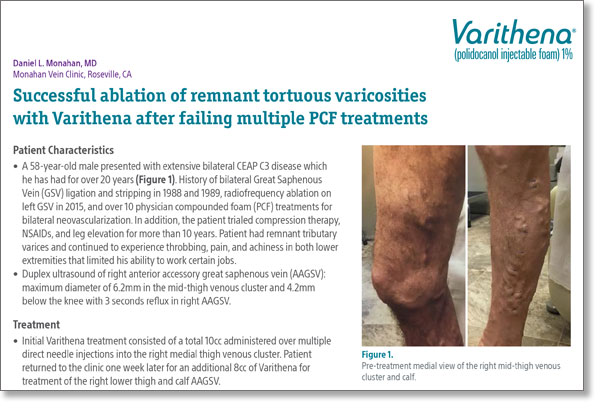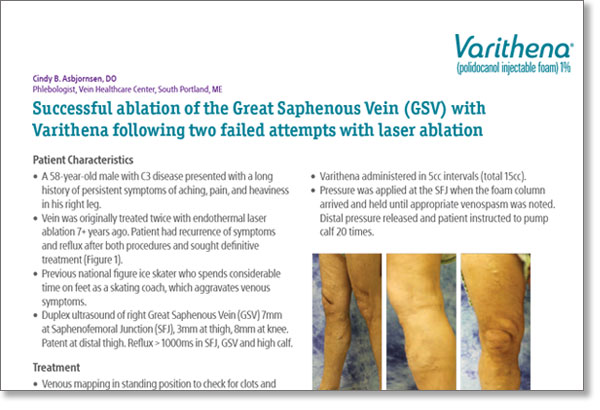
Varithena case studies
Many lives impacted. One versatile treatment.
Like you, Varithena treats above and below the knee. See why this versatile treatment has become indispensable to so many physicians.
Bilateral, Tortuous, Distal GSV, Proximal GSV
After 8 years impaired quality of life
After eight years of impaired quality of life due to venous incompetence, Varithena treatment leads to improved symptoms and appearance.
Bilateral, Tortuous, Distal GSV, Proximal GSV
Minimal downtime and symptom improvement
44-year-old male presented with tortuous varicose veins and severe symptoms including swelling, pain, skin discoloration, and itching. His symptoms were worsened by his profession which required long hours on his feet.
Bilateral, Distal GSV, Proximal GSV
Improvement in both symptoms and appearance
A 68-year-old male requested a consultation after symptoms interfered with his work and daily activities. His symptoms included bilateral torturous varicose veins that were tender to the touch, ankle swelling, skin discoloration, leg pain, and restless legs.
Proximal GSV
Duplex ultrasound evaluation of a large refluxing branch of the GSV
A 68-year-old, otherwise healthy, male with lifelong severe bilateral varicose veins presented to the clinic with pain, heaviness, itching and foot discomfort.
Proximal GSV, Tortuous
Duplex ultrasound evaluation of a tortuous, recurrent varicose vein
A 59-year-old male patient presented with a history of varicose veins in bilateral lower extremities since he was a teenager.
Proximal GSV, Distal GSV
Impact of Varithena treatment on patient-relevant outcomes
A 52-year-old female presented to the clinic with bilateral leg symptoms. She reported that her most severe symptoms were consistently tired legs that felt heavy.
Proximal GSV, Distal GSV
Significant improvement of reflux and symptoms
36-year-old mother presented to the clinic with ankle swelling, leg cramps, heaviness and tender varicose veins.
Proximal GSV
Varithena treatment of the GSV
A 35-year-old mother of four presented with recurrence of bilateral refluxing varicosities after previous thermal ablation treatment at another facility. Her symptoms included leg fatigue, heaviness and ankle swelling.
Tortuous, Proximal GSV, Distal GSV
Successful ablation of remnant tortuous varicosities
A 58-year-old male presented with extensive bilateral CEAP C3 disease which he has had for over 20 years. History of bilateral Great Saphenous Vein (GSV) ligation and stripping in 1988 and 1989, radiofrequency ablation on left GSV in 2015, and over 10 physician compounded foam (PCF) treatments for bilateral neovascularization.
Proximal GSV
Successful ablation of GSV with Varithena
A 58-year-old male with C3 disease presented with a long history of persistent symptoms of aching, pain, and heaviness in his right leg.
* Results from case studies are not necessarily predictive of results in other cases. Results in other cases may vary.
Order
Varithena
Add to your practice with this versatile, efficient, and consistent varicose vein treatment. Order directly from Boston Scientific.
Become Varithena certified
Join the 2,000+ certified physicians improving patients’ lives with Varithena. We’re here to help you, and becoming certified is easy.

Contact a sales representative
Have your local Varithena
sales representative
contact you.

Join the physician
finder
Patients want to know who’s performing Varithena procedures. Get noticed by potential patients.
Indications
Varithena® (polidocanol injectable foam) is indicated for the treatment of incompetent great saphenous veins, accessory saphenous veins and visible varicosities of the great saphenous vein (GSV) system above and below the knee. Varithena® improves the symptoms of superficial venous incompetence and the appearance of visible varicosities.
Important Safety Information
The use of Varithena® is contraindicated in patients with known allergy to polidocanol and those with acute thromboembolic disease. Severe allergic reactions have been reported following administration of liquid polidocanol, including anaphylactic reactions, some of them fatal. Observe patients for at least 10 minutes following injection and be prepared to treat anaphylaxis appropriately. Intra-arterial injection or extravasation of polidocanol can cause severe necrosis, ischemia or gangrene. Patients with underlying arterial disease may be at increased risk for tissue ischemia. If intra-arterial injection of polidocanol occurs, consult a vascular surgeon immediately. Varithena® can cause venous thrombosis. Follow administration instructions closely and monitor for signs of venous thrombosis after treatment. Patients with reduced mobility, history of deep vein thrombosis or pulmonary embolism, or recent (within 3 months) major surgery, prolonged hospitalization, or pregnancy are at increased risk for developing thrombosis. The most common adverse events observed were pain/discomfort in extremity, retained coagulum, injection site hematoma or pain, common femoral vein thrombus extension, superficial thrombophlebitis, and deep vein thrombosis.Physicians administering Varithena® must be experienced with venous procedures, possess a detailed working knowledge of the use of the duplex ultrasound in venous disease and be trained in the administration of Varithena®.
See Full Prescribing Information for Varithena®
Varithena™ is a registered trademark of Boston Scientific. All other trademarks are property of their respective owners.
PI-1263705-AA


